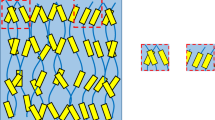Abstract
An hypothesis has been developed to explain in a semi-quantitative fashion the wide variations in time required for the equilibration in the skeleton of various radioactive substances when they are introduced into the circulation. The basis for the hypothesis rests on the assumption that three variables define the rate-limiting step in bone exchange: a) the rate of perfusion of bone, b) the concentration of the ion plasma, and c) the concentration of the ion in bone. Using this idea and data from the literature, “cycling times” were calculated for Cl−, Na+, K+, and Ca++. They were found to vary by four orders of magnitude (from 10 min for Cl− to 64 days for Ca++ in the rat).
These predictions were tested for22Na- and45Ca-exchange in a column of apatite mineralin vitro. In vivo 36Cl- and42K-exchange in rat femur was studied. The blood disappearance of22Na in man was also examined. Finally, data in the literture of45Ca-exchange in the rat molar was redrawn. In every case, experimental results closely approximated the predictions of the cycling concept.
Some of the implications of these findings are briefly discussed.
Résumé
Une hypothèse, destinée à rendre compte de façon semi-quantitative, des grandes variations de temps nécessaire à équilibrer, au niveau du squelette, divers produits radioactifs, introduits dans le torrent circulatoire, est mise au point. Cette hypothèse est basée sur le fait que 3 facteurs interviennent dans les échanges osseux: a) la vitesse de perfusion de l'os, b) la concentration ionique du plasma, et c) la concentration ionique de l'os. Partant de cette hypothèse et de résultats publiés dans la littérature, “des temps de cyclage” sont calculés par Cl−, Na+, K+ et Ca++. Ils varient selon quatre ordres de grandeur (de 10 min pour Cl− à 64 jours Ca++, chez le rat).
Ces résultats ont été vérifiés pour des échanges de22Na et de45Ca dans une colonne d'apatite minéralin vitro. Des échanges de36Cl et de42K ont été étudiésin vivo au niveau du fémur de rat. La disparition sanguine du22Na a été suivie chez l'Homme. Enfin des résultats d'échanges de45Ca, au niveau de molaires de rat, publiés dans la littérature, ont été recalculés. Dans chaque cas, les résultats expérimentaux ont confirmé les prédictions de l'hypothèse du cyclage.
Zusammenfassung
Es wurde eine Hypothese aufgestellt, um auf semi-quantitative Weise die breite Variabilität der Zeit zu erklären, die benötigt wird, um im Skelett ein Gleichgewicht von verschiedenen radioaktiven in den Kreislauf eingeführten Substanzen herzustellen.
Diese Hypothese beruht auf der Annahme, daß der geschwindigkeitsbeschränkende Faktor beim Knochenaustausch durch 3 Variablen definiert ist: a) das Maß der Knochenperfusion, b) die Konzentration der Ionen im Plasma und c) die Konzentration der Ionen im Knochen. Auf Grund dieser Annahme und gestützt auf Angaben aus der Literatur wurden die “cycling times” für Cl−, Na+, K+ und Ca++ berechnet. Diese variieren in 4 Größenordnungen, beispielsweise von 10 min für Cl− bis zu 64 Tagen für Ca++ bei der Ratte.
Diese Annahmen wurden für den Austauschin vitro von22Na und45Ca in Apatitmineral in einer Säule geprüft. Der Austausch von36Cl und von42K wurdein vivo am Rattenfemur studiert. Die Abnahme von22Na im menschlichen Blut wurde ebenfalls verfolgt. Schließlich wurden Literaturangaben über den Austausch von45Ca in Rattenbackenzähnen überprüft. Die Versuchsresultate kamen dabei sehr nahe an die auf Grund des “cycling concept” erwarteten.
Einige der Zusammenhänge dieser Befunde werden kurz besprochen.
Similar content being viewed by others
References
Aubert, J. P., F. Bronner, andL. J. Richelle: Quantitation of calcium metabolism Theory. J. clin. Invest.42, 885–897 (1963).
—, andG. Milhaud: Methode de mesure des principales voies du metabolisme calcique chez l'Homme. Biochim biophys. Acta (Amst.)39, 122–139 (1960).
Bauer, G. C. H., A. Carlsson, andB. Lindquist: Evaluation of accretion, resorption, and exchange reactions in the skeleton. Kgl. Fysiogr. Sällsk. i Lund, Förh.25, 1–16 (1955).
Bluhm, M., J. MacGregor, andB. E. C. Nordin:In vitro andin vivo studies with bone seeking isotopes. In: Radioaktive Isotope in Klinik and Forschung (K. Fellinger andR. Hofer, eds.), vol. 4, p. 29–36. Munich: Urban & Schwarzenberg 1960.
Bronner, F., J. P. Aubert, L. J. Richelle, P. D. Saville, J. A. Nichols, andJ. R. Cobb: Strontium and its relation to calcium metabolism. J. clin. Invest.42, 1095–1104 (1963).
Buchanan, D. L., andA. Nakao: Turnover of bone carbonate. J. biol. Chem.198, 245–257 (1952).
Copp, D. H., andS. S. Shim: Extraction ratio and bone clearance of Sr85 as a measure of effective bone blood flow. Circulat. Res.16, 461–467 (1965).
Eisenberg, E., andG. S. Gordan: Skeletal dynamics in man measured by non-radioactive strontium. J. clin. Invest.40, 1809–1825 (1961).
Heaney, R. P., andG. D. Whedon: Radiocalcium studies of bone formation rate in human metabolic bone disease. J. clin. Endocr.18, 1246–1267 (1958).
Levinskas, G. H.: Solubility studies of synthetic hydroxyl apatite. Thesis University of Rochester 1953.
Neuman, W. F., andM. W. Neuman: Chemical dynamics of bone mineral. Chicago: Chicago University Press 1958.
Pak, C. Y. C., andF. C. Bartter: Ionic interaction with bone mineral, I and II. Biochim. biophys. Acta (Amst.)141, 401–420 (1967).
Robinson, R. A.: Observations regarding compartments for tracer calcium in the body. In: Bone biodynamics (H. M. Frost, ed.), p. 423–439. Boston: Little, Brown & Co. 1964.
Rowland, R. E.: Exchangeable bone calcium. Clin. Orthop.49, 233–248 (1966).
Spector, W. S. (ed.): Handbook of biological data, p. 279. Philadelphia: W. B. Saunders Co. 1956.
Shimmins, J., andD. A. Smith: Estimation of bone mineral transfer rate by the measurement of long-term retention of Sr85. Metabolism15, 436–443 (1966).
Triffitt, J. T., A. R. Terepka, andW. F. Neuman: A comparative study of the exchangein vivo of major constituents of bone mineral. Calc. Tiss. Res. (in press).
Weikel, J. H., Jr., andW. F. Neuman: Incorporation of dietary radiocalcium into skeleton of rats. Metabolism10, 83–90 (1961).
Author information
Authors and Affiliations
Rights and permissions
About this article
Cite this article
Neuman, W.F., Terepka, A.R., Canas, F. et al. The cycling concept of exchange in bone. Calc. Tis Res. 2, 262–270 (1968). https://doi.org/10.1007/BF02279214
Received:
Issue Date:
DOI: https://doi.org/10.1007/BF02279214




